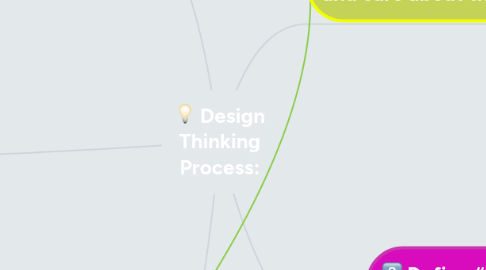
1. Prototype:“Build to think and test to learn.”
1.1. What
1.1.1. Building representation of the ideas to get feedback from user
1.2. How
1.2.1. Gather feedback
1.2.2. To fail quickly and cheaply
1.2.3. Don’t spend too long on one prototype
1.3. Why
1.3.1. carry out many possibilities
2. Ideate: “It’s not about coming up with the ‘right’ idea, it’s about generating the broadest range of possibilities.”
2.1. What
2.1.1. concentrating on idea generation
2.1.2. a process of “going wide”
2.1.3. the fuel and the source material are provided
2.2. How
2.2.1. combining your conscious and unconscious mind
2.2.2. embracing misunderstanding
2.2.3. Coming up with many solutions as you can
2.3. Why
2.3.1. for a widest quantity of ideas
3. Test“Testing is an opportunity to learn about your solution and your user.”
3.1. What
3.1.1. soliciting feedback
3.1.2. framing of the problem and created prototypes to test
3.2. How
3.2.1. Evaluate
3.2.1.1. what worked?
3.2.1.2. what didn't
3.2.2. Irate & scale
3.3. Why
3.3.1. informing the next iterations of prototypes
3.3.2. opportunities to build more empathy
4. Empathize: “To create meaningful innovations, you need to know your users and care about their lives.”
4.1. What
4.1.1. Learn about your audience
4.1.2. understand the way users do things.
4.2. How?
4.2.1. Observe who is your user?
4.2.2. Engage
4.2.3. Watch and Listen
4.3. Why
4.3.1. gives you clues
4.3.2. learn about what users need precisely
4.4. Example: Field Observation with Fresh Eyes’ video (on the Oral B kids toothbrush)
4.4.1. Tom Kelley with his team was challenged to design a new children's toothbrush
4.4.2. The team put themselves on the kid's shoe (users) to know their exact needs
4.4.2.1. therefore, they clearly define the problem
5. Define:“Framing the right problem is the only way to create the right solution.”
5.1. What
5.1.1. create a point of view that is based on your user's needs
5.1.2. making sense of the widespread gathered information
5.2. How
5.2.1. Synthesize
5.2.1.1. select the NEEDS
5.2.2. Work to express INSIGHTS
5.2.3. “How-Might-We . . .?
5.3. WHY
5.3.1. results in your point-of-view (POV)
5.3.2. POV defines the RIGHT challenge to address

